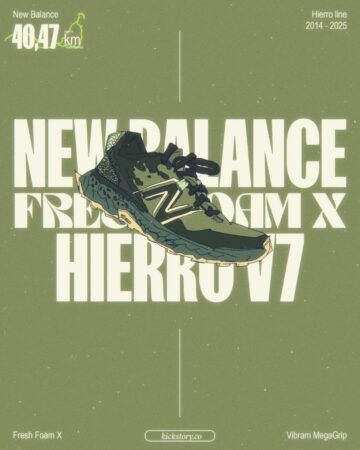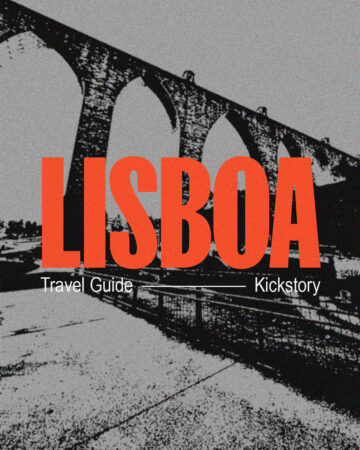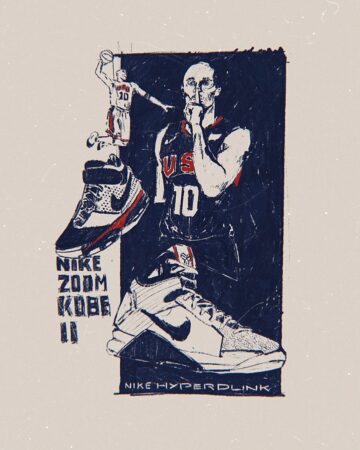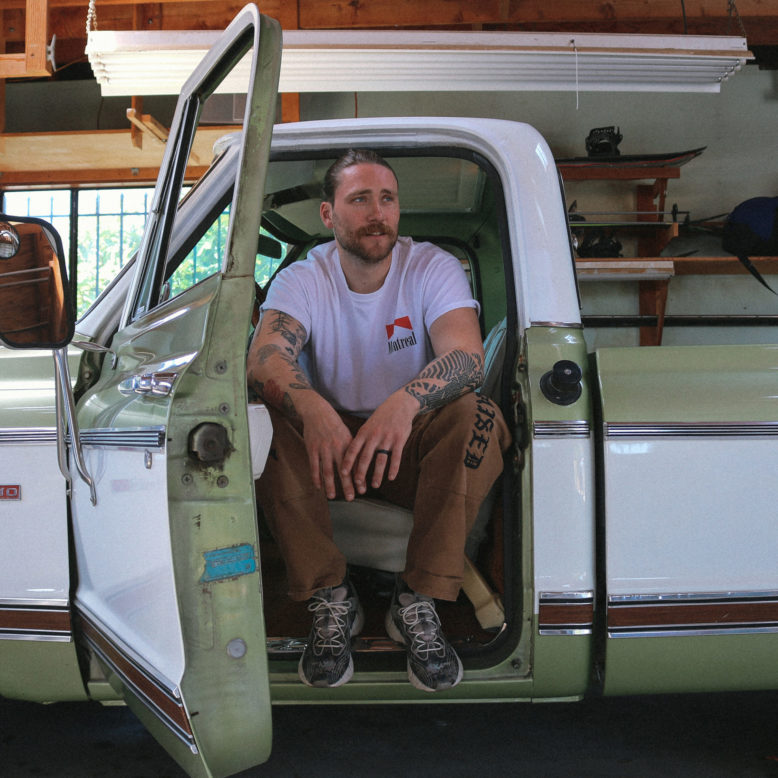
If you’ve been keeping up with what Reebok has been releasing over the past few years, you’ve definitely seen Marc V. Brosseau’s work. Being huge admirers of his work for a long time, he was the first person we spoke to when we decided to make our trip to the United States.
Marc worked as a designer at Reebok for 7 years and today he works at adidas culture collaboration and partnerships mostly focused on Ivy Park. His list of projects at Reebok is extensive and ranges from Sole Fury to collaboration with Cardi B, several editions of Club C and especially the Zig Kinetica II in numerous versions and collaborations of the model.
He welcomed us to his studio in Los Angeles, where we talked a lot about design, the way he approaches his projects and how he uses his famous bootlegs to express himself.
For his interview Marc chose to talk about a shoe that was a very important milestone in his life – the Billionaire Boys Club x Reebok Zig Kinetica II. A sneaker that he designed, and got the chance to put a lot of himself, personal references from his life and some of his own tastes.
Overall, Brosseau provides a unique insight into the sneaker industry and how design can impact culture and fashion. His experience and perspectives are valuable to anyone interested in design, fashion and culture.
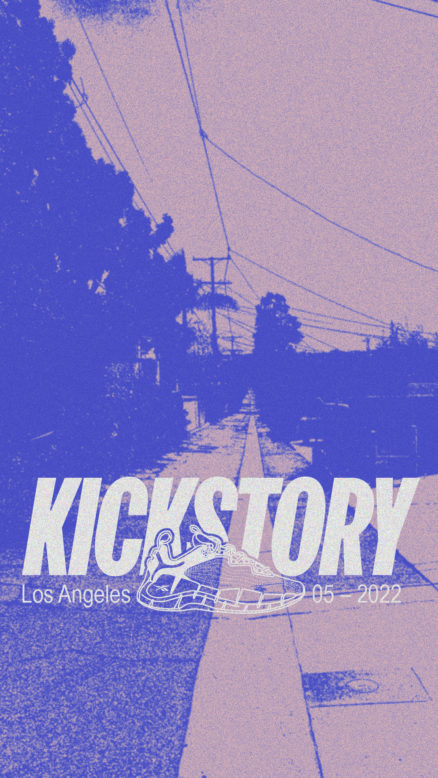


“My name is Marc V Brosseau. I am currently the senior footwear designer for adidas Ivy Park collection footwear. I’ve been designing footwear for 10 years. I grew up in Canada, and I have an industrial design background, which led me to interning at Reebok where I worked for seven years. I worked at Reebok in almost every category from innovation to Classics, Zigs, sports, Tech-Style, CrossFit, and then I finished up running the design for the streetwear collaborations as part of the energy team with Leo Gamboa, and just an amazing team. So I did a lot of stuff there.
Before I was a designer, I was a semi-professional biathlete on the Canadian Biathlon national team. For those who don’t know, biathlon is cross-country skiing and shooting, it’s an Olympic sport. The discipline that I learned from the sport translated to design in the way that it shifted my focus to really be immersed and concentrated in the design world. It also gave me a fresh perspective on translating the things I learned as a user of footwear.
That’s when I began to understand the disconnect between the functional side of it, the performance, the race, and then the style side of it because, I was a skater kid growing up, but then cross-country skiing is not a skater-cool sport at all, right? So you’re wearing tights, carbon fiber, everything’s red, black, and carbon fiber. I would chuck my boots in the back of my car and have a pair of skate shoes out there ready to go. I mean, It feels weird to fill up your car at a gas station wearing ski boots (laughs). So I always thought there was more to the space that lives between sport and lifestyle and I don’t think they’re quite as segregated as they once have been. Merging the gap between both sides has a lot to do with my design philosophy and combining worlds – meshing them together.”
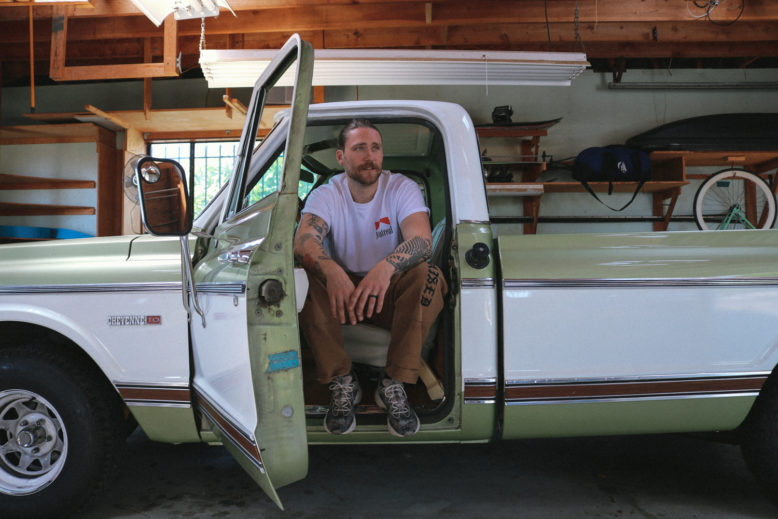
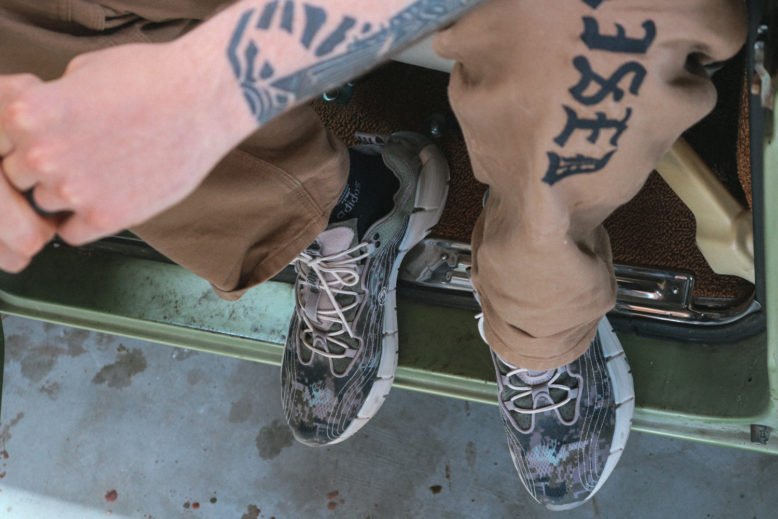
As a biathlon athlete you were customizing your own rifles. Was that how you became into design?
marc I would modify my rifle every season. I would take out the Dremel and start carving pieces out, and it was a growth experience to learn how to not be precious with things that other people put value on. I was really into custom cars and I learned how to airbrush and how to do car painting. So I started doing these really elaborate custom paint jobs on rifles.
Higher-level athletes would see my rifles and ask if I could do some work on theirs. I started doing the customs for other people, to a lot of my friends. They’re inherently functional things so I want them to be pretty, but it doesn’t matter if they’re pretty but not functional. To me, it was always that combination of the two, they could do both – and I couldn’t let go of that idea. When I got into design, the sports world and footwear specifically seemed to be the best place for me to focus that interest.
“I would take out the Dremel and start carving pieces out, and it was a growth experience to learn how to not be precious with things that other people put value on.”

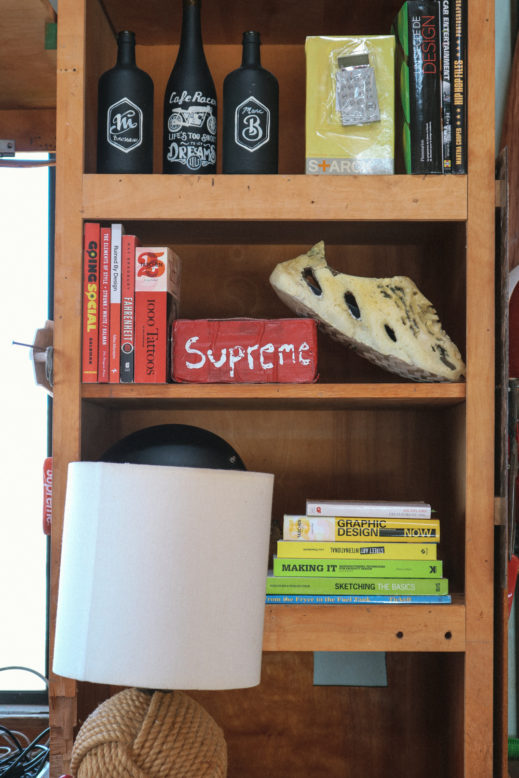
And how did you go from customizing biathlon rifles to footwear design?
marc I just studied general industrial design and I was obsessed with industrial design history. People like the Eames, Raymond Loewy, and these iconic industrial designers, whether it be car design or furniture design, I was really interested in it, but I couldn’t wrap my head around the idea of them making something relevant for a long period of time, and have such an impact on design culture, and just general pop culture. I became obsessed with that idea and I felt that footwear was that next frontier because of the pace at which we create stuff for footwear.
There’s two components to this business. The first one is commodity, so people go to T.J. Maxx to buy a shoe that looks okay but it costs $60. Those are disposable and that’s a big, big part of the business. But there’s also a part of the business that’s full of emotion, where people have a visceral connection to the product. And I was really interested in how you can make something that has purpose and a real connection to what it’s meant to do, but then it’s so specifically built that people grow an attachment to it outside its original purpose.
I think a lot of that perspective comes from the fact that where I grew up you could buy sneakers, but the special stuff only existed in magazines. There was no distribution, no streetwear shops. This t-shirt I’m wearing is from Off the Hook which is a “streetwear” store in Montreal, and they were the only ones around. You couldn’t just go buy style, it just wasn’t around. So I think you see a lot of creative people coming out of these non-standard markets. People think New York or L.A. is where it happens, but the people who are there, don’t come from there, they come from places where they couldn’t get the stuff that they had. They’re creative because they had to make with what they had. You can’t buy style, you have to create it, you embody it, and you have to have a certain level of confidence that comes from trial and error. And just being like “I think this is cool, therefore that’s enough.”
“People think New York or L.A. is where it happens, but the people who are there, don’t come from there, they come from places where they couldn’t get the stuff that they had. They’re creative because they had to make with what they had. You can’t buy style, you have to create it, you embody it, and you have to have a certain level of confidence that comes from trial and error.”
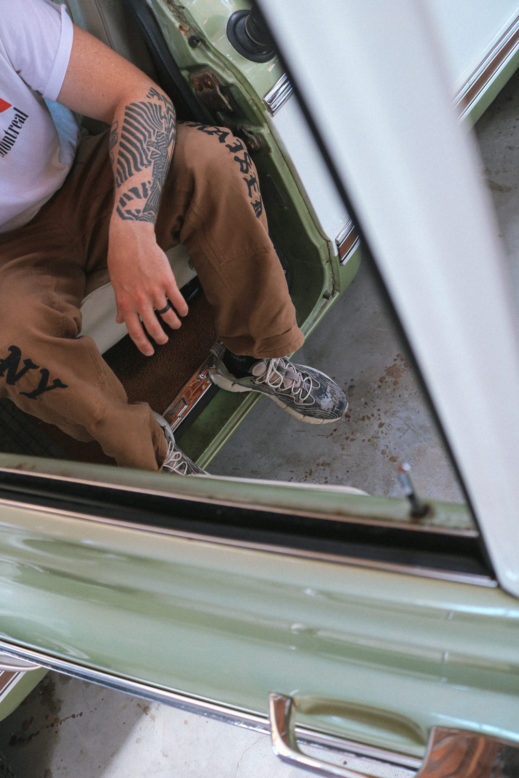
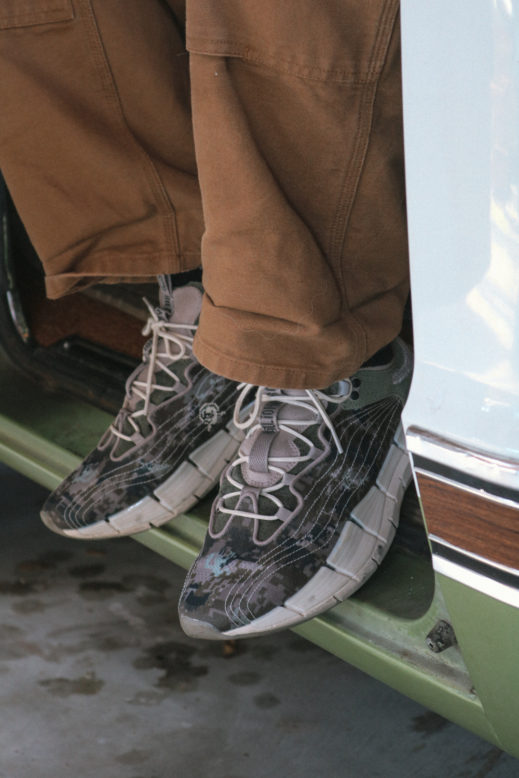
When you were still in Montreal, were you already into streetwear and sneakers? Or that's something that came later on in your life?
marc I was but I wouldn’t call myself a sneakerhead. I liked style in general, I was interested in the way certain silhouettes looked with certain outfits. To me, it was never about getting the right pair of Air Force ones, it was going to find stuff at TJ Maxx and looking for things I thought were cool and weird, things I thought I could make it work.
I always liked footwear but I was never in tune with the whole storytelling that was happening. The narrative was just different where I grew up. There wasn’t like “this player exclusive basketball shoe, or it’s relevant because of this color” – yeah, but that color is ugly. Who cares? I was not precious with it.
When I started working on the Reebok Innovation team, I’d start asking people basic questions: “would you wear it? What do you want to wear and why? Why do you like it?” Because I want to make things I want to wear. If it’s a sports shoe we don’t have to make it only black and lime green. Let’s make it cream, with a white bottom and a gum outsole. And this is what I did for the Reebok Nano 7 – I was the first one to do white Nanos with gum bottoms, even though that colorway was always reserved for the classic space.
Nanos are really good for CrossFit, but now those people want to go to the grocery store in their jeans after their workout wearing their Nanos. But when we make sporty colors, it doesn’t make sense. So I made a bunch of black gum Nano’s, some retro hits to make it more close to what they would do in classics. And those colors, they still make them today – black, white, and gum Nanos, are still one of the best-selling colors. But before the Nano 7 the brands had never done it.

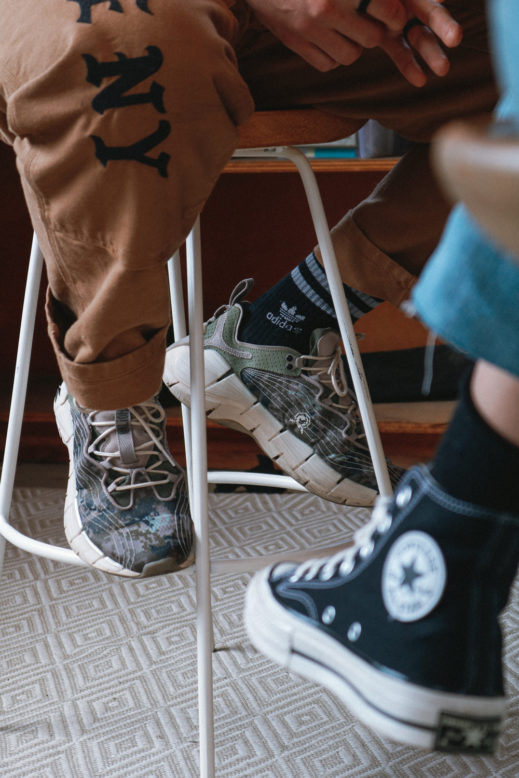
You worked at Reebok for seven years. How was the first interaction with the brand, and how did you get the job?
marc I was about to sign a contract with another company because I had to get an internship to graduate from school, and I had worked in France for a little bit. I was having a really hard time finding a job in footwear because a lot of these companies don’t really hire people at a low level that need visas and I didn’t know that. Then in June, luckily out of nowhere, Reebok called me. They saw I had done a school project on footwear where I had made everything from scratch myself, and they just reached out like “hey, we have this apprentice program, it’s going to start in July. Just come down here we’ll help you get a visa, you can come here for a whole year”. I still had a year left in school and had already taken a year off, so I couldn’t do it. But they said “we’ll make it a summer thing, just come on down”. They were really helpful and supportive, and I have a lot of love for that brand and the people inside of it because my life would have been a lot different had that not happened. I was really grateful and excited at the time.
So I packed my stuff in my little Honda Civic and moved to Boston. While I was there I met my wife and made some really good relationships. I started in the classics team and I got to work on my first collab, which was on a Classic Leather exclusive for Overkill’, which is a sneaker boutique in Berlin. They were doing an Oktoberfest shoe at the very last minute, and they didn’t have anyone to do it so they were like “this kid is good with colors, just give it to him”. And I was like “I could do so much more than color” (laughs), but at the end of the day we had a lot of fun. There were three colorways, they were really popular and sold out. That was my first sneaker that I had worked on, that came out.
I had gotten close to the Vice President, head of footwear design, Dan Hobson, and he was a mentor for a long time and a good friend. He saw something in me that maybe I wasn’t seeing yet, and he took me under his wing. When I got hired to come back to Reebok full-time, they put me on the running team. And I was like “running team? Okay, cool, that’s a really good opportunity to learn”. I’d love to do performance products because, in classics, you don’t do a lot of new midsoles because it’s all retros. So one day I showed up, and they were like “you’re on the innovation team”. I didn’t know what that meant, but it got me excited.
I got to work there for a long time and I created the Reebok Sole Fury with the rest of the team, really driving the nail into the need for that space between the classics and the performance side. That shoe did really well, they got people excited, and that created the need for the brand to have this space that lives between the two – sports and style. At that time it was called Tech-Style, then that team became Zig, then the streetwear stuff came after it.
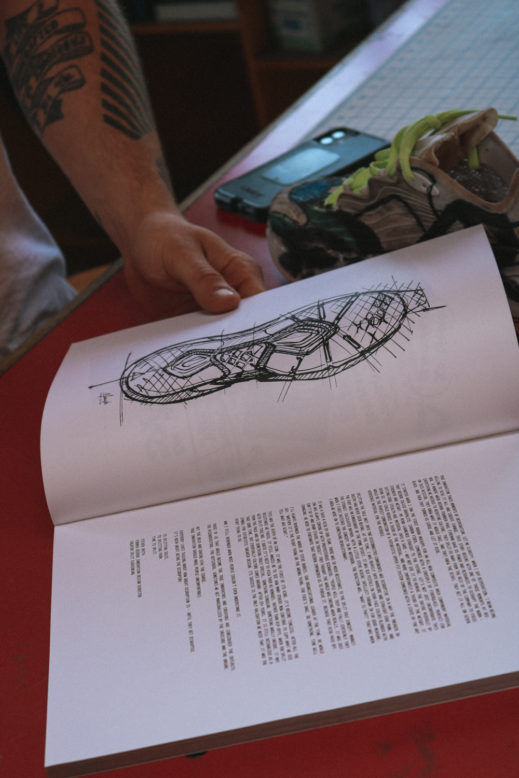
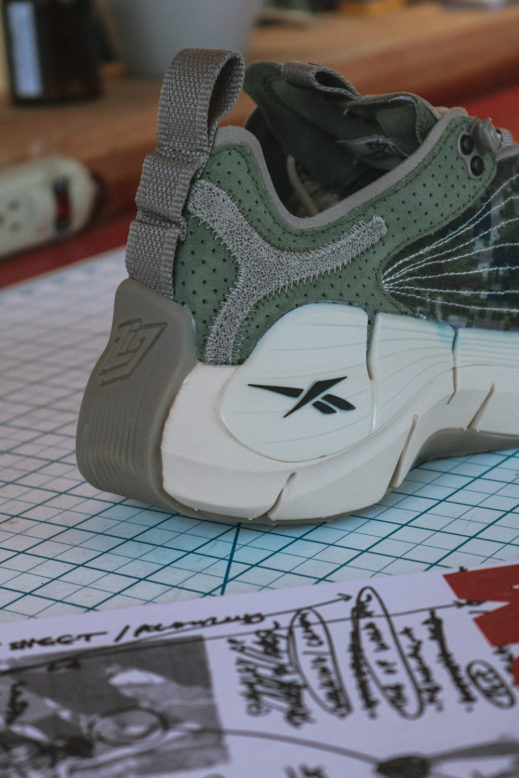
For us, Reebok shoes have a unique look and quality to them. One of the things that caught our attention in your work was that you were able to really capture that Reebok vibe in the products you created. What is your approach to working on these classic silhouettes and creating new ones with the brand's DNA?
marc The reason these shoes are different enough for people to appreciate and familiar enough for them to recognize what they are, is that I don’t fall in love with this stuff. I look at it from an external observer’s point of view. Let’s say you are a designer for Nike Air Max: too many times people really love the silhouette and it’s really hard for them to think “this could be better”, because they might think this is the best thing that ever existed. And I never had that feeling for a lot of things. I’m always thinking that something can be improved, I see what it could be.
The Reebok Sole Fury, originally, was inspired by the Reebok Ventilator. The Ventilator was re-released when I was an intern and I thought it was the most stupid shoe – not because of its idea, the idea was awesome, but it’s the idea of ventilation in 1980 something, when all the shoes were made of cut and sew leather. You can’t call this thing the ventilator now when it has a little piece of mesh on the side of it, that doesn’t ventilate anything.
We started with the ventilator as an idea, and we took that idea as far as we could. It didn’t look the way it did in the beginning, the first sketches were really crude and they had a split sole because the whole bottom of the shank was supposed to be a carbon fiber plate that had ventilation under the whole foot. Eventually, we shifted the uppers and did some changes that needed to be done. So, we focused on the story around the Fury because the Fury was really about putting all the technology Reebok had at that time into a shoe that has 30 pieces – and back then shoes normally had over 100 pieces. So it’s all about taking that ethos of “if it doesn’t do anything, if it doesn’t serve a purpose, it’s gone”. We had that idea of making something that looked wild, but was actually quite simple.
“We focused on the story around the Fury because the Fury was really about putting all the technology Reebok had at that time into a shoe that has 30 pieces – and back then shoes normally had over 100 pieces. So it’s all about taking that ethos of “if it doesn’t do anything, if it doesn’t serve a purpose, it’s gone”. We had that idea of making something that looked wild, but was actually quite simple.”

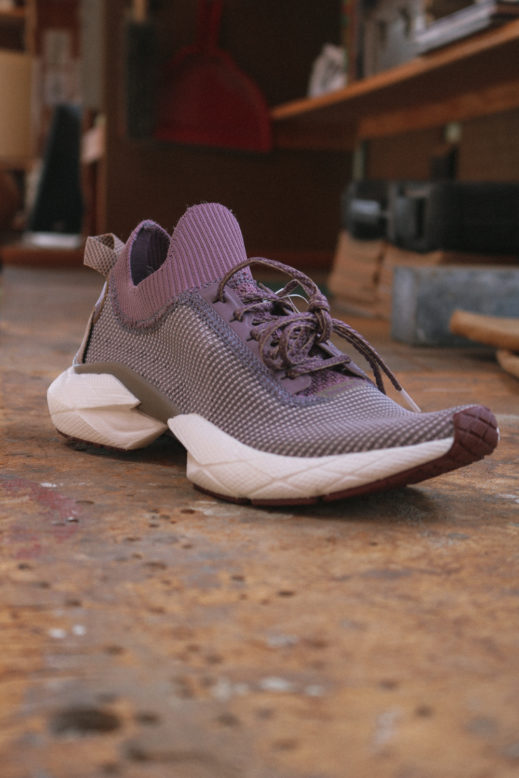
How much creative space did you have when you were working in the innovation team?
marc A lot. I gave myself a lot because I’m a very practical guy. You could have talked to Mike about this too since we were on the same team. We would get these briefs and it basically said dead in the water on them, and still some of them made it to market. A brief for creation is very literal and one-to-one execution. Sometimes the ideas are up-to-date but there are people that see that as being very restrictive. But the design isn’t in the brief – that’s the checklist of what you need to do to be successful. But the design, the creativity, the “Oh my God, I’ve never seen that before” feeling – that doesn’t live in the brief, that lives in all the whitespace between those “rules”. And that’s when I play outside of it.
If I had read the brief for Sole Fury the way it was written, I would have made something that was inevitably a stylized version of something that existed. But instead, I was like, “let’s look at the things that we like, and let’s not take the pieces of them literally, that we want to keep. Let’s take the essence of why we like those pieces.” That feeling of it being super lightweight, and fast, let’s take the novelty out of the pieces. Why was that impactful then? That’s the feeling that we need to replicate, not the shape.
“A brief for creation is very literal and one-to-one execution. Sometimes the ideas are up-to-date but there are people that see that as being very restrictive. But the design isn’t in the brief – that’s the checklist of what you need to do to be successful. But the design, the creativity, the ‘Oh my God, I’ve never seen that before’ feeling – that doesn’t live in the brief, that lives in all the whitespace between those ‘rules’. And that’s when I play outside of it.”

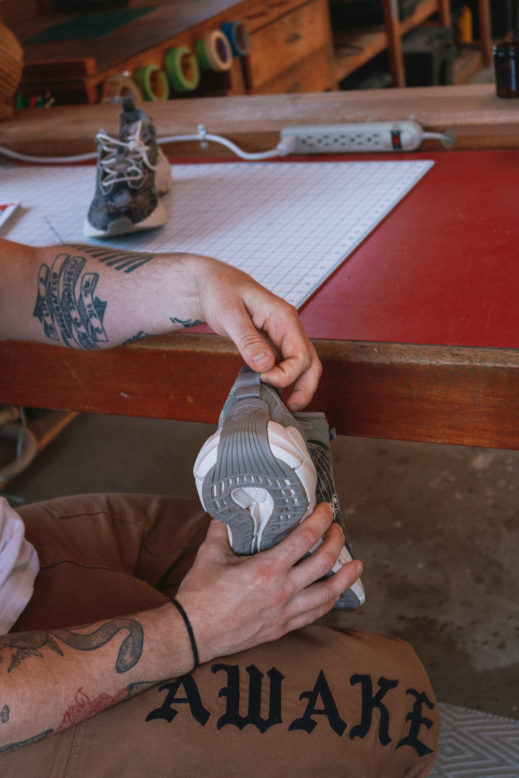
And how do you take on these projects creatively?
marc It’s very fluid. I think my personal superpower is always asking myself what I want to make. I’m always asking “What do I want to wear right now that I am not seeing? What is on the market right now that is almost what I want…but how does it need to evolve for me to be interested in it?” So I’m always testing the water and when the briefs come I usually have a bag of ideas that I’ve just been simmering. So I spend a lot more time upfront thinking about what I want to make than sitting down and doing it.
I try to find the thing that the project needs for people to get on board. Sometimes that’s a really beautiful sketch, especially if it’s an evolution of something that exists. Sometimes that’s a 3d model, and I’ll work with the 3d modeling team. Often it’s a sketch with a prototype.
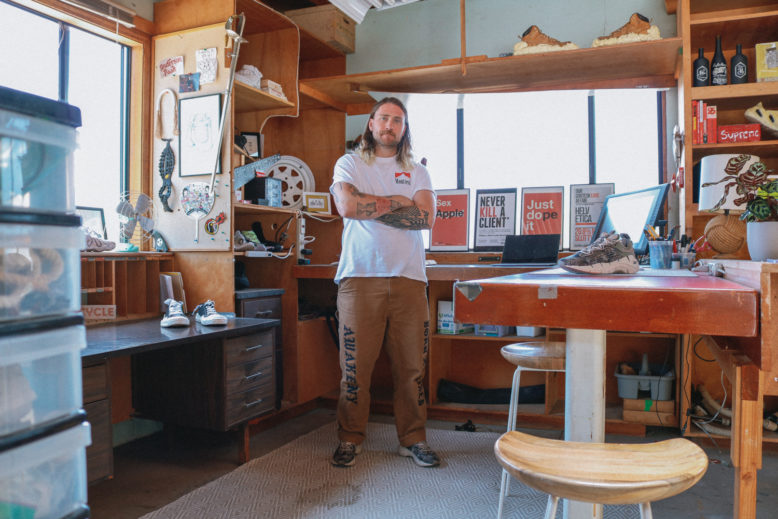
For his interview David Filar chose the Reebok Zig Kinetica Edge 2, which you got to work on together. It was a shoe you designed and he worked on the Vibram outsole. How did that project come together?
marc The briefing was that we needed to do an update to an existing trail shoe. And right away I knew I wanted to put a Vibram outsole on it. I was friends with David and we brought him in. There was a lot of skepticism at first and people weren’t getting it. I made all these sketches, so I had a presentation and I was like “they’re not gonna get it. Just telling the story, it won’t get the amount of attention that it deserves”.
That’s really where the bootlegging came from. I’ve got a presentation about this shoe to a senior leadership in 30 minutes, and I was thinking of what I could make in 30 minutes that’s not gonna shoot me in the foot. So I had these old trail shoes that I designed, I went into the maker lab, and I just started cutting pieces up and gluing on them with a hot glue gun and doing changes. I’d make a little shroud and stuff, and put paper inside of it to hold it up. I always did that kind of stuff when I was on the innovation team, but I always thought no one wanted to see that. It was really rough because I always did that for me, that’s for my idea-generating process. I would only show these really finished polished things but eventually, I realized, especially with Instagram, that people want to see the cruder stuff. And so I made this prototype.
The sole already existed from the Zig and it was also an existing upper. I removed the outsole from that upper, cut it off, and glued it there. I was just chopping up stuff real crude and rough and would take existing pieces and go like “I like this piece on this thing, I like this piece here”, and people would love it. So I leaned into it, but I like to do it quickly. For the Zig I had 30 minutes.
It worked, they liked it. I went from no one really understanding why this project needed to exist to everyone’s thinking “this is going to be the thing, we got to do it”. The narrative changed immediately. And then I understood the value of prototyping. And this is years into my career. I always thought my sketches weren’t good enough, I gotta keep refining them. But I don’t think the answer was in the sketching…designers love sketches but in the business, we’re not all designers.
“I went from no one really understanding why this project needed to exist to everyone’s thinking ‘this is going to be the thing, we got to do it’. The narrative changed immediately. And then I understood the value of prototyping.”


You've been making some really fun bootlegs versions of these hype sneakers and some of them have really blown up on social media. Where did this idea come from, and when did you start making them?
marc I do it all the time. There’s levels to it: there’s the five-minute thing, and then there’s the “I can make something that looks like the real thing”, and that takes a lot more time. So it depends on what I’m trying to achieve. In the end, it’s just fundamental prototyping tools and industrial design learning.
It took me a long time to see the value in it, and it really came as kind of a joke. I did a lot of footwear design, which for Reebok felt avant-garde and futuristic, and I would be really proud of that work, of that sketch. But then I put it on Instagram and no one cared. It was really emotionally hard to see it being like a drop in the bucket, no one cares, it was just really hard.
Or, I would do something that I thought was really right for the brand, on trend, really nicely shaped, and the comments would be like “Oh, that looks like a Yeezy” or “a Reebok Yeezy.” If by Yeezy you mean on-trend, avant-garde styling, or some really clever sculpting, then yeah, I’ll take it. But it was meant as a diss to me. It really hurt my feelings for a long time but eventually, I thought it was really funny. And I was like “how do I turn this into a joke?”
One of my friends who had worked on “The 10” collection, he did the Off White x Converse Chuck Taylor. So he had the real Off White laces, but he put them on random white Chucks, then he wrote “bootleg” with quotation marks on the midsole and then he drew the CDG heart on them. There’s a “I don’t give a fuck” vibe in it and there’s also a level of confidence like “I can make something that’s a verbal mockery or a bootleg. But it’s cool because I’m wearing it.” There’s a level of confidence in that that I really admired.
Two, three years later, the Zig comes out and people are saying “looks like a Yeezy” and I’m like, “What are you talking about? Looks nothing like a Yeezy”. So I was like “You can turn anything into Yeezy if you draw Yeezy on it.” So I made those and people thought it was really funny, and then, I drew the Yeezy 700 on the Zig.
As people got interested in it, I started getting haters. Some people were commenting, “Dude, get a real job and just buy the real shoes” (laughs). I wanted them to be shitty on purpose, so some people were getting it, and some people weren’t – and I was really entertained by that idea. You know enough about sneakers to know what’s up, but you don’t know enough about me to know that it was a joke. So I loved it. It really gave me a sense of letting go, detaching my self-worth from my work and having a good time doing it. And also taking a piss out of what we do for a living – it’s just shoes. At the end of the day, it’s just shoes.
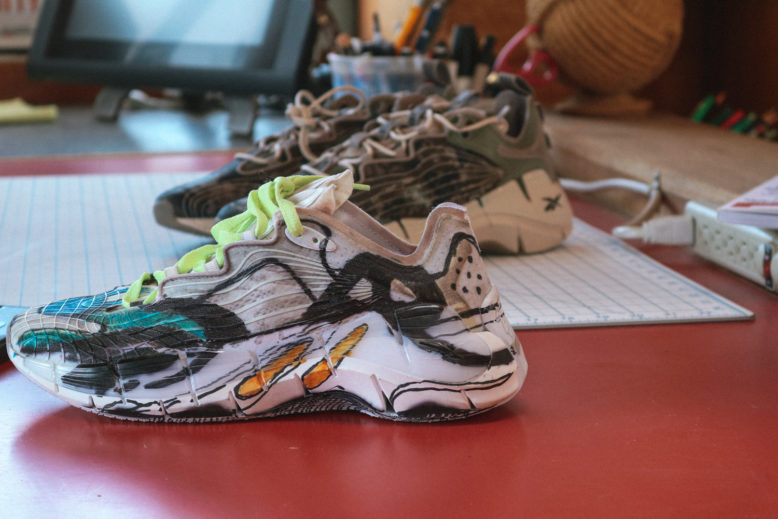
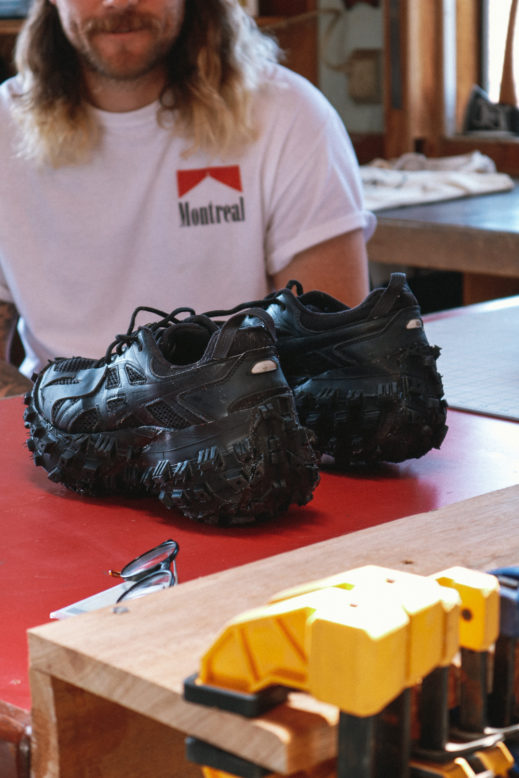
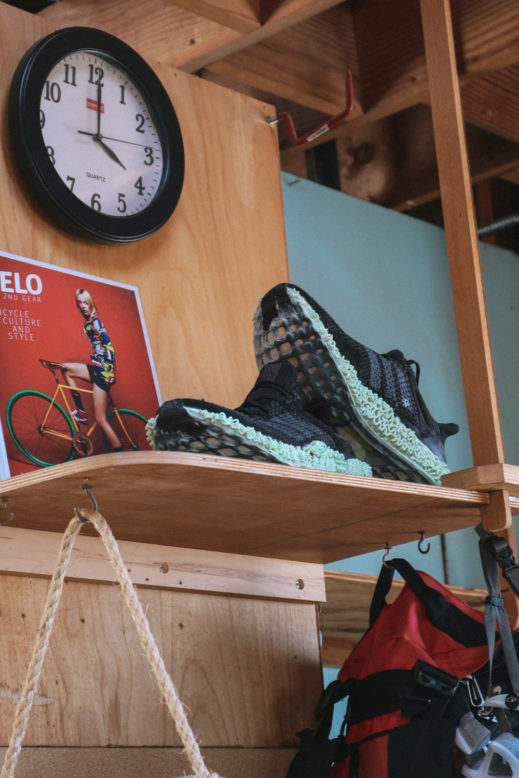
And why out of all the projects and collaborations that you have done, and the sneakers you own, you specifically chose this Billionaire Boys Club x Reebok Zig Kinetica II for your Kickstory?
marc I’m not a nostalgic person and there’s not a shoe I could pinpoint growing up that changed my life. But the reason I picked this particular shoe, is that this shoe actually did change my life. It is a really important marker in time for me. I designed the Zig shoe as an inline product, the regular non-collab version, and I put a lot of time and effort into it, I was very committed to it. Obviously, there’s a team behind everything, but the design itself had a lot of me in it.
It was really flattering for me to have the guys at Brain Dead, BBC, A$AP Nast, liking the shoe enough to want to do collaborations on it. And then it coincided with me finishing the Zig shoe with my transition into the streetwear team. And so I got to do these collaborations on a shoe that I had designed. A lot of the shoes that I worked on in collabs were shoes that were from other parts of the business that other designers had designed, and I would come in and help those partners put their touch on it, and really help them execute their vision. But this was one of the only ones where I had designed the original shoe and also got to work on the collab with a partner.
Joseph Au, who is the creative director at Billionaire Boys Club, we just had a really good vibe. He’s really into vintage workwear and vintage military garb, especially the really nice Japanese stuff that you can find in thrifting. We wanted to give that sense of nostalgia by using an OG BBC print, the digi camo and because they have a really rich archive of camos – being that it’s the Pharrell and Nigo world. It felt relevant, so I was like “what if we built this the way a military tent or a military retro jacket would have been built?” Because they’re inherently functional, and so was Zig.
We had a lot of fun, everything that was hot melted, bonded, and all-around clever engineering on the original sporty version, we turned into craftsman-type details that were focused on durability. The colors are totally my personal taste, to wear something like this with just a beige midsole with the heights, and stuff is just something I would do.
So that’s why I picked it, there’s a lot of me in this. And I had the help of such amazing people. To me, this shoe is a marker in time for a transition that led me to what I’m doing now. And it’s funny because this shoe is old for me. I’ve been working on the Zig for four years, since 2018. I did versions on versions, the trail version, I did the collabs and stuff. So the fact that I still am into it after all this time, it’s really something special.
“A lot of the shoes that I worked on in collabs were shoes that were from other parts of the business that other designers had designed, and I would come in and help those partners put their touch on it, and really help them execute their vision. But this was one of the only ones where I had designed the original shoe and also got to work on the collab with a partner.”


As you mentioned, this shoe has a lot of military references, like the stitching and the camo. What's the story behind it?
marc I’m an Army brat. My father was in the military, I grew up loving military uniforms, my mom runs what was my dad’s business where they do a lot of repairs for military tents and stuff. So I was always interested in the way that military garments are put together because there’s a beauty to how functionally practical it is. The stitching is usually pretty rough on a lot of functional military stuff because they use such heavy gauge materials and such heavy gauge thread, that it’s really hard to keep everything straight and clean. So that’s why we wanted to use the really thick gauge thread here.
Having these kinds of detail we took from military jackets, like the Molly strap which is just like a staple of military outfitting and I tried to capture some of that, even down to the leather that we picked. We wanted it to look like this crackled leather that you see on these old bomber flight jackets. The storytelling I think comes down to the camo itself, it has a lot of story for BBC. It’s actually not really a camo, it’s just a bunch of little pictograms of iconic BBC emblems like the tiger, there’s a cowboy with a little pistol and stuff like that, the astronaut helmet which we wanted to be really visible, so we hid it on the medial side. And this back here was a request from the BBC team, where they wanted to put “wealth is of the heart and mind, not the pocket” which is like Pharrell’s mantra for the brand. Joe had this vintage Medicare kit that he sent me and he was like “I love this material with the patch on it”. So, we were like, “Okay, Let’s replicate that”. So it’s Type Z 2 because it’s the Zig Kinetica 2. And then he just made these codes for when the shoes are going to come out.
So, if no one picks up on that attention to detail, that’s fine with me. But it’s what makes it good. And people can feel that someone cared enough to do that, whether they know the whole thing or not.

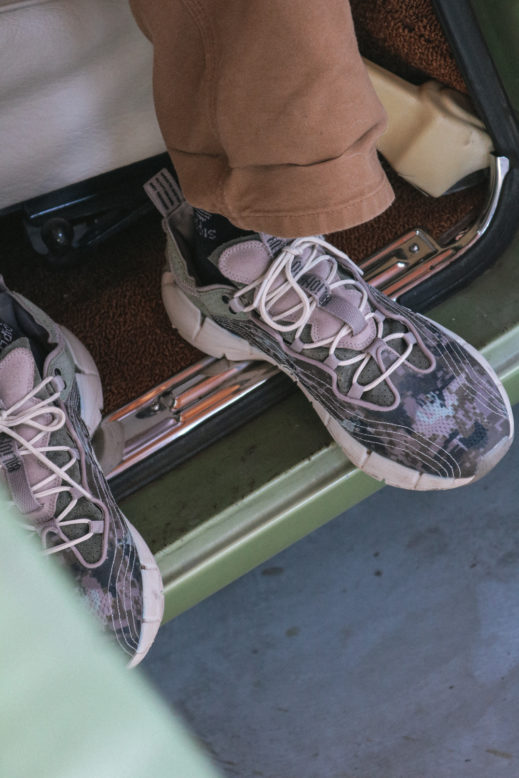
And how has your transition to adidas been? Can you tell us a little bit of what you've been doing for Ivy Park?
marc We have some really cool stuff in the pipeline that I’m excited about. So maybe to preface this: I worked on the first Cardi B signature shoe for Reebok, and that highlighted that there’s this unserved part of sneaker culture for women. And it’s crazy because the angle for that is completely different from traditional sneakerheads. When the Cardi B stuff was posted on the right channels, it was all love. But then you would go to a Nice Kicks, Sneaker Freaker, and had OG basketball, liking guys and they be like “this is trash, Cardi B is this and that.” And they’ve hated it.
I started to realize that there’s something here that I could bring what I’ve been doing to expand on this untapped market. And the important part is that I think there are tons of women who appreciate sneakers, but the sneakerhead part of it is unique to them, they have their own take on it, and they come at it very differently. Whereas there are some guys who will get these crazy colors dunks, and they make an outfit to make the dunks work. And women, some of them do that, but I think most of them will think of the thing a lot more holistically.
The shoe has to come in and complement the cut of pants, or the dress, or the onesie, or whatever that they’re wearing, and they’ll think on how the ankle, to the cuff of the pants, to the shoe come together. It’s a totally different approach to design. I really enjoy doing the research part of it because the formula is not going to work if we just keep doing it the same way. I have a lot of fun doing it that way and I think the results speak for themselves.
I’ve been doing a lot of stuff, the first part was getting used to a new brand, a new design philosophy and different creative partners because everyone brings something different. They all want to see a different facet of themselves inside of the product. At the end of the day, my name is not on those shoes, they’re not made for me, I’m here to bring their vision forward. I’m really excited, and I’m very proud of some of the stuff we’ve made. I hope that in 2023 there will be some really cool products that make waves.
“I started to realize that there’s something here that I could bring what I’ve been doing to expand on this untapped market. And the important part is that I think there are tons of women who appreciate sneakers, but the sneakerhead part of it is unique to them, they have their own take on it, and they come at it very differently.”
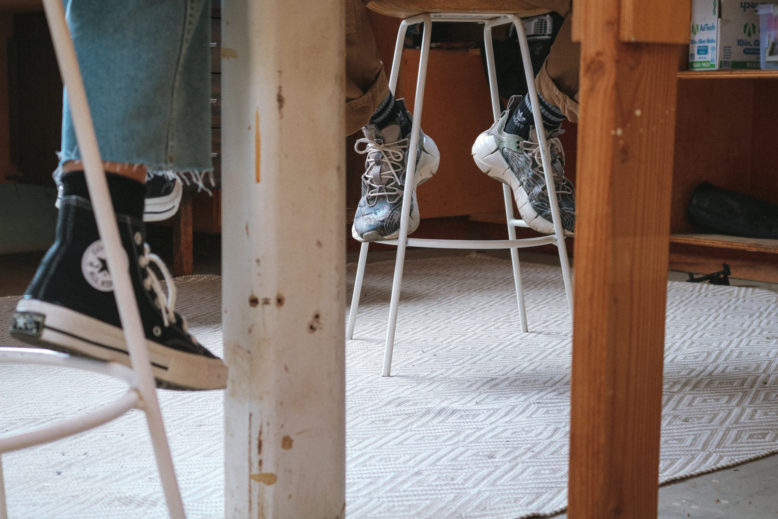
And for Ivy Park, do you work on existing silhouettes or are you creating new stuff?
marc The whole Ivy Park collection there’s always been an expected level of freshness on it, and I think the stuff that I did at Reebok was the same. Everything is on a sliding scale of: this needs a little bit of newness, this needs a lot of newness, or this is a totally new thing. Some of the stuff that we’ve worked on is really inventive color usage. Ivy Park has a really strong narrative. What they bring is so much more than fashion, it’s like Beyonce’s general aura.
That’s why I love the streetwear space so much, because there’s a lot of hidden storytelling, there’s a lot of “you had to be there, you had to be paying attention the whole time, if you want the whole story.” Because we’re putting it out there, we want you to know it and there’s so much to absorb.
Well, as we said many times, we really admire the work that you have put out. Whether it is giving something classic a new vibe to it, or creating something new that carries some history within its details. You can see the richness and the energy that has been put in that shoe. What do you think makes people so connected to these sneakers?
marc I do believe that in sneakers, there are three levels at which people absorb them. The first one is seeing them from far away – the shape is recognizable enough to be “that’s a Dunk, or that’s a Gazelle”, that shape is a form of branding as its own. The second one is from like six feet away or if I’m talking to the person. I can see the shoes toe down point of view, there’s a superficial level of details. That’s got to be considered, but then what really sells is that third level at six inches away – you pick it up in person, you feel the materials, you see the details and little hidden details inside that you would never see in a photo of the shoe. At that level, the object moves away from being a commodity, to a collectible, and people become emotionally connected to the story. And that’s really important to me.
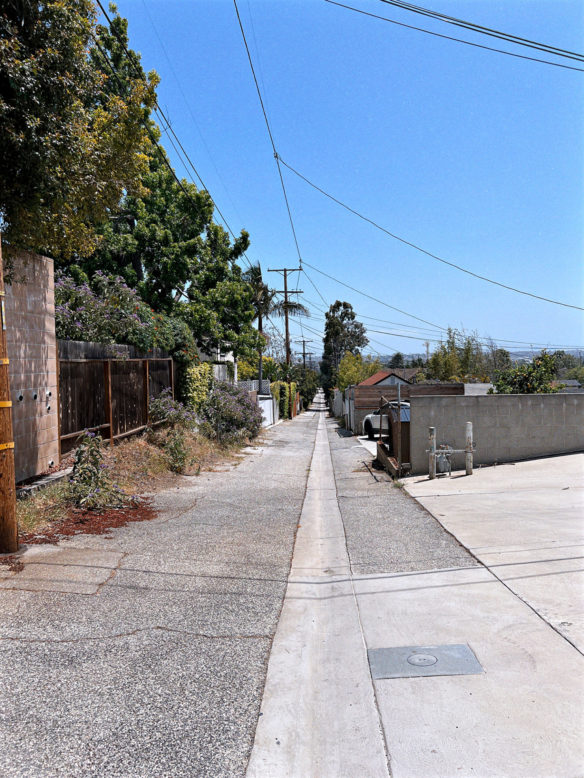
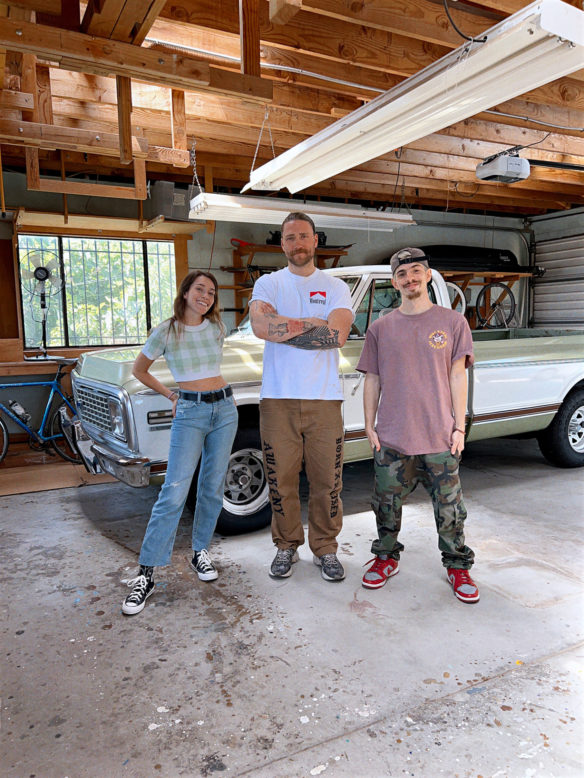
Billionaire Boys Club x Reebok Zig Kinetica II
Owner: Marc V. Brosseau
Photos: Kickstory
